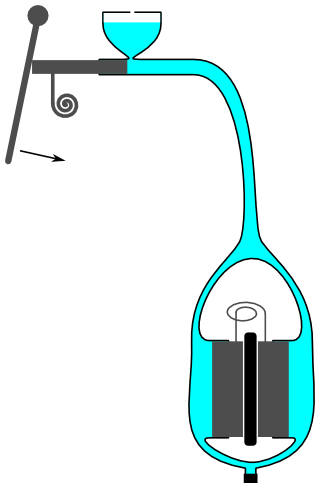Hydraulic Brakes
irony
Posts: 43
I don't have hydraulic brakes but at some point will get some. As such I wanted to understand how hydraulic brakes work so drew up a diagram which some may find useful;

On applying the brake lever the piston is pushed past the expansion tank hole and thus hydraulic pressure is applied to the brake pads. The pads have a greater area than the piston so the force is greater (force being pressure times area) but the distance moved is very small.
To put fresh fluid into the system the bleed nipple is opened at the bottom of the system and more fluid poured into the expansion tank. The fresh fluid is pumped into the system by applying the brake lever repeatedly. Bubbles in the system are also removed in the same manner by expelling them through the bleed nipple via adding fresh fluid to the expansion tank and pumping it through.
One thing I haven't quite figured is how do the pads self adjust to account for wear or does one adjust them over time like with V brakes?

On applying the brake lever the piston is pushed past the expansion tank hole and thus hydraulic pressure is applied to the brake pads. The pads have a greater area than the piston so the force is greater (force being pressure times area) but the distance moved is very small.
To put fresh fluid into the system the bleed nipple is opened at the bottom of the system and more fluid poured into the expansion tank. The fresh fluid is pumped into the system by applying the brake lever repeatedly. Bubbles in the system are also removed in the same manner by expelling them through the bleed nipple via adding fresh fluid to the expansion tank and pumping it through.
One thing I haven't quite figured is how do the pads self adjust to account for wear or does one adjust them over time like with V brakes?
0
Comments
-
the pads are returned after each application but the seals. when the distance pushed is greater than the distance returned then they have adjusted themselves.
you concept of bleeding the brakes is the most simplistic posible.
have a read of each makers manuals or the info on park tools."Do not follow where the path may lead, Go instead where there is no path, and Leave a Trail."
Parktools :?:SheldonBrown0 -
related question: if your brake levers feel "slack" or take a few cm's to actually apply the brakes, would that be due to having a low fluid level in your brakes?
also, i've been told that if you press your brakes while the caliper isn't on the disk (for cleaning/removal etc etc) the caliper will close and be difficult to open again.is this because of the adjusters? any way of rectifying it if it happens?
Ben0 -
nicklouse, the diagram is for myself and anyone who doesn't know about disc brakes - it just to give a basic understanding of the mechanism, for example until I drew the diagram I didn't understand how the expansion tank worked whereas now I can see how the brake lever blocks it off when operated.
Similarly the diagram explains why turning turning the bike upside down maybe a poor idea as air can get into the system - does this mean that if repair a tyre puncture I shouldn't turn the bike upside down as I do with my V brake bike?
Details of bleeding is given here;
http://www.parktool.com/repair/readhowto.asp?id=1260 -
on most brakes turning the bike upside down causes no issues. As they are all sealed."Do not follow where the path may lead, Go instead where there is no path, and Leave a Trail."
Parktools :?:SheldonBrown0 -
-
Yes the "expansion tank" normally has a membrane covering it.
Also the self adjustment happens because as you let the lever back out, the spring returns the lever. The "suction" in the brake pipe pulls the pads back but only until it clears the opening to the resevoir. At that point it sucks in an amount of new fluid exactly in proportion to the amount of pad you've just worn. So every single application of the brakes it readjusts the tiny amount necessary which is why everything else being equal, your bite point never moves."Internet Forums - an amazing world where outright falsehoods become cyber-facts with a few witty key taps and a carefully placed emoticon."0 -
Yes I can see that the brake lever spring would pull the pads back.
But the only way I can see that the wearing surface of the pads would keep the same distance apart is if instead of them being attached to a fixed spring they were instead on some sort of spring attached by friction.
Here I shown the pad springs as not embedded in the pads but simply pushing on them - thus as the pads wear they will slip along the endballs of the spring... however my solution doesn't seem a very smooth way of keeping the wearing surface of the pads a fixed distance apart; 0
0 -
All the pad springs do is keep the pads in contact with the pistons and away from the rotor when released to stop them rattling and scuffing the rotor when not required. They do not return the pistons when the brake is released, they are no-where near strong enough to do that. That is done hydraulically by the return of the matster cylinder.
The mechanism for taking up wear is as I described previously."Internet Forums - an amazing world where outright falsehoods become cyber-facts with a few witty key taps and a carefully placed emoticon."0




